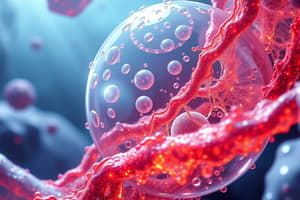Podcast
Questions and Answers
What does the term 'fluid mosaic' describe?
What does the term 'fluid mosaic' describe?
- Protein function
- Membrane structure (correct)
- Phospholipid composition
- Cell structure
What is selective permeability?
What is selective permeability?
A property of biological membranes that allows some substances to cross more easily than others.
Define diffusion.
Define diffusion.
The spontaneous movement of a substance down its concentration gradient.
What is a concentration gradient?
What is a concentration gradient?
What is passive transport?
What is passive transport?
Define osmosis.
Define osmosis.
What does tonicity refer to?
What does tonicity refer to?
What does isotonic mean?
What does isotonic mean?
What is hypotonic?
What is hypotonic?
What does hypertonic refer to?
What does hypertonic refer to?
What is osmoregulation?
What is osmoregulation?
Define facilitated diffusion.
Define facilitated diffusion.
What is an aquaporin?
What is an aquaporin?
Define active transport.
Define active transport.
What is exocytosis?
What is exocytosis?
Define endocytosis.
Define endocytosis.
What is phagocytosis?
What is phagocytosis?
What does pinocytosis refer to?
What does pinocytosis refer to?
What is receptor-mediated endocytosis?
What is receptor-mediated endocytosis?
Define energy.
Define energy.
What is kinetic energy?
What is kinetic energy?
Define heat in terms of energy.
Define heat in terms of energy.
What is potential energy?
What is potential energy?
Define chemical energy.
Define chemical energy.
What is thermodynamics?
What is thermodynamics?
What is the first law of thermodynamics?
What is the first law of thermodynamics?
Define entropy.
Define entropy.
What is the second law of thermodynamics?
What is the second law of thermodynamics?
Define cellular respiration.
Define cellular respiration.
What is an exergonic reaction?
What is an exergonic reaction?
Define endergonic reaction.
Define endergonic reaction.
What is metabolism?
What is metabolism?
Define metabolic pathway.
Define metabolic pathway.
What is energy coupling?
What is energy coupling?
What does ATP stand for?
What does ATP stand for?
What is phosphorylation?
What is phosphorylation?
Define activation energy.
Define activation energy.
What are enzymes?
What are enzymes?
Define substrate.
Define substrate.
What is the active site?
What is the active site?
What is induced fit?
What is induced fit?
Define cofactors.
Define cofactors.
What is a coenzyme?
What is a coenzyme?
Define competitive inhibitor.
Define competitive inhibitor.
What is a noncompetitive inhibitor?
What is a noncompetitive inhibitor?
What is feedback inhibition?
What is feedback inhibition?
Flashcards are hidden until you start studying
Study Notes
Membrane Structure and Transport
- Fluid Mosaic Model: Describes the membrane as a diverse mosaic of protein molecules within a fluid phospholipid bilayer.
- Selective Permeability: Membranes allow some substances to cross while blocking others, essential for cell function.
- Diffusion: Spontaneous movement from a region of higher concentration to one of lower concentration.
- Concentration Gradient: Indicates how the density of a substance varies in space; cells maintain gradients to facilitate movement.
- Passive Transport: Movement of substances across membranes without energy expenditure, relying on concentration gradients.
- Osmosis: Diffusion of water through a selectively permeable membrane.
- Tonicity: Influences whether cells gain or lose water based on surrounding solution concentrations.
Solution Types
- Isotonic: No net water movement as solute concentrations are equal inside and outside the cell.
- Hypotonic: Surrounding solution causes cells to gain water, potentially leading to swelling.
- Hypertonic: Surrounding solution results in water loss from the cell, causing it to shrink.
Cellular Processes
- Osmoregulation: Maintaining solute balance and regulating water gain/loss within cells.
- Facilitated Diffusion: Requires specific transport proteins for substances to move across membranes down their concentration gradients.
- Aquaporins: Specialized transport proteins that enhance water movement across cell membranes.
Active Transport Mechanisms
- Active Transport: Moves substances against their gradient, requiring energy input (ATP).
- Exocytosis: Process of expelling materials from a cell via vesicle fusion with the plasma membrane.
- Endocytosis: Uptake of substances through vesicle formation from the plasma membrane, including types like phagocytosis and pinocytosis.
- Receptor-Mediated Endocytosis: Specific uptake of molecules via vesicles organized around receptor-protein complexes.
Energy Concepts
- Energy: Capacity to perform work or cause change.
- Kinetic Energy: Energy of motion; relates to moving objects.
- Potential Energy: Energy stored due to position or arrangement; includes chemical bonds and gravitational potential.
- Thermodynamics: Study of energy transformations in matter.
Laws of Thermodynamics
- First Law: Energy conservation; energy can’t be created or destroyed, only transformed.
- Entropy: A measure of disorder; increases with energy transformations, mirroring the second law.
- Second Law: Every energy conversion results in increased entropy, implying a reduction in order.
Metabolism and Reactions
- Cellular Respiration: Aerobic breakdown of food to liberate energy usable by cells.
- Metabolism: Total chemical reactions in an organism, encompassing both energy-releasing and energy-consuming pathways.
- Energy Coupling: Utilizes energy from exergonic reactions to fuel endergonic reactions.
ATP and Reactions
- ATP: Main energy currency of cells; provides energy for various biological processes.
- Enzymes: Biological catalysts that accelerate chemical reactions without being consumed.
- Activation Energy: Minimum energy required for reactants to start a chemical reaction.
- Substrate: Specific reactant on which an enzyme acts, with each enzyme having unique substrates.
Enzyme Functionality
- Active Site: Region on an enzyme where substrates bind, critical for catalysis.
- Induced Fit Model: Enzyme dynamically alters its shape upon substrate binding for optimal interaction.
- Cofactors and Coenzymes: Additional nonprotein molecules or organic compounds needed for enzyme activity; vitamins often serve as coenzymes.
- Inhibitors: Molecules that decrease enzyme activity; competitive inhibitors block active sites, while noncompetitive inhibitors alter enzyme structure without engaging active sites.
- Feedback Inhibition: A regulatory mechanism where the end product of a pathway inhibits an enzyme within that pathway, helping maintain homeostasis.
Studying That Suits You
Use AI to generate personalized quizzes and flashcards to suit your learning preferences.




